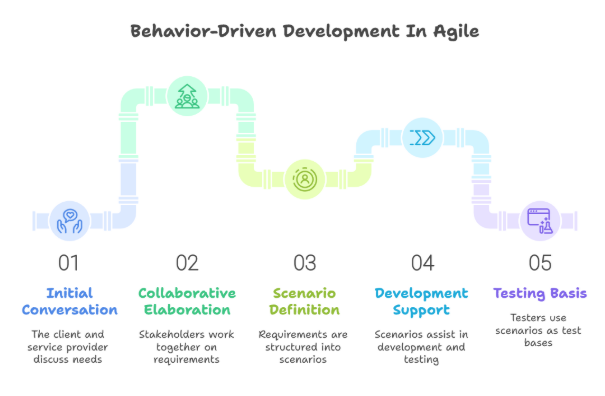BDD in Testing: Improve Automation & Team Productivity

Behavior-Driven Development (BDD) is revolutionizing the conventional approach to automation testing. BDD allows software teams to write simple and readable test scenarios in plain English using Given-When-Then, which is more collaborative and communicative in nature to deliver better products. Aligning these tests to business needs allows BDD to help improve automation productivity, reduce miscommunication, and ultimately generate more team productivity.
In this blog, we will discuss how BDD has gained prominence over the years, its impact on automation, popular tools, and future trends. We will also learn how teams integrate BDD in testing workflows for an effective development and delivery mechanism of software.
Understanding BDD and Its Importance
Behavior-Driven Development (BDD) is a software development process that increases interaction between developers, product teams, and business stakeholders. BDD uses a human-readable string format to describe the feature specifications (like Gherkin), which in turn induces the development to closely match the business goal.
Because BDD focuses on behavior specification, it provides a particularly valuable mechanism in Agile environments, where rapid iterations and continuous collaboration are essential. BDD helps eliminate ambiguities and communication gaps, which reduces redundancies in the development workflows by putting user behavior at its center.
Below is the diagram for the Behavior-Driven Development for the whole software lifecycle in Agile, ensuring collaboration and clarity throughout the software lifecycle by defining, developing, and testing features based on expected user behaviors.
When comparing TDD vs BDD, TDD focuses on writing tests before the code, while BDD emphasizes writing tests in natural language. BDD is a way to go for teams that are looking for methods to help them build quality software that meets the functional requirements but also addresses the needs of real users in the real world.
What is BDD Testing?
BDD testing is a collaborative approach that can ensure the software can easily be tested considering its behavior by defining plain scenarios in a human-readable language in the form of the specification. It bridges the gap among business stakeholders, developers, and testers by writing how an application should behave from an end-user standpoint.
BDD testing core principles:
- Business-Driven Scenarios: Test cases are described using a simple, structured syntax (e.g., Gherkin).
- Collaboration-Focused: Promotes a common understanding between teams to avoid miscommunication.
- Test Automation Friendly: Works with automation frameworks like Cucumber, SpecFlow, and Behave.
- Living Documentation: BDD tests are a form of living documentation that evolves with the software.
Automate your BDD testing on an AI-powered continuous test automation platform.
Why Use BDD in Testing
BDD ensures that the applications are validated based on real-world user behavior by defining test scenarios in plain language (for example, Gherkin syntax). Thus making the tests more understandable for developers, testers, and business stakeholders.
Top use cases for BDD in testing:
- Enhancing Collaboration: BDD helps eliminate miscommunication between business teams and developers by aligning expectations from the start.
- Improving Test Automation: One can view BDD scenarios as formalized expected behavior, which can be integrated into automated test suites using frameworks like Cucumber, SpecFlow, and Behave.
- Increasing Regression Testing Efficiency: BDD verifies business-critical functionalities continuously after code changes.
- Functioning Simultaneously: BDD is used in cross-functional Agile teams to determine behavior-driven test cases that enable development and testing to be driven concurrently.
Limitations of BDD Testing
BDD promotes collaboration and clarity in testing, but it has some limitations.
- Initial setup complexity: BDD demands team training, framework installation, and stakeholder agreement, making it initially cumbersome.
- High maintenance effort: Application behavior tends to change over time and therefore, you need to frequently update your Gherkin scenarios, leading to a lot of maintenance overhead.
- Requires strong collaboration: BDD only works with the active participation of business stakeholders, developers, and testers.
- Not ideal for UI & performance testing: BDD works best for functional and acceptance testing but is less effective for UI-heavy or performance tests.
Popular BDD Testing Frameworks
There are a few popular BDD testing tools and frameworks that assist teams in adopting behavior-driven testing by turning plain-language scenarios into executable test scripts:
- Cucumber: One of the most popular BDD frameworks, it allows you to write test cases in a human-readable way using Gherkin syntax. The Cucumber testing framework can integrate with Selenium, Appium, and REST-assured for automation.
- JBehave: A Java-based BDD framework that allows easy integration with JUnit and supports behavior-driven testing in big business applications.
- SpecFlow: Designed for. NET applications, SpecFlow is an excellent choice for Microsoft ecosystems by enabling BDD test execution in C#.
Steps to do BDD Testing with ACCELQ
ACCELQ, as a modern automation platform, aligns very well with BDD to provide a seamless environment for both technical and non-technical stakeholders. Here’s how ACCELQ can transform your BDD testing:
1. Discovery
The Discovery phase is where stakeholders collaborate to explore and define project requirements, ensuring all roles (business analyst, developer, tester, product owner, etc.) work together.
2. Definition
During this phase, the common knowledge captured during Discovery is transformed into explicit, verifiable specifications that can be executed.
3. Automation
The Automation phase aims to convert defined specifications into automated acceptance tests. These tests verify whether the software works according to the defined scenarios. Automated testing frameworks and tools like ACCELQ are used to create executable tests that can be repeatedly run against the software.
Using NLP (Natural Language Processing), ACCELQ enables a very simple way of writing test cases in the simple English language. It generates test cases automatically from test scenarios, eliminating the need for manual input and saving valuable time.
Future Trends in BDD Testing
BDD testing is continuously growing with more automation, AI addition, & CI/CD integration. For example, with the advent of self-healing test automation, AI learns the UI structure automatically. If any change is made to the UI, the test scripts are automatically updated, which helps to reduce maintenance efforts. Also, the use of smart Natural Language Processing (NLP) will further enhance BDD features, making them more intuitive and easier for non-technical stakeholders.
Cloud-based test execution and parallel testing will bring more scalability and efficiency to BDD in Agile and DevOps environments.
Conclusion
BDD in testing opens up a whole new world for automation testing in the best possible manner, resulting in better communication around test scenarios and looking at the story from a business perspective. By integrating BDD, teams can increase test automation efficiency, reduce ambiguities, and improve software quality. BDD provides structured test cases and a clear behavioral specification to ensure that the automation tests are relevant, reusable, and scalable.
Tools like ACCELQ help you take the best benefits out of BDD. With BDD in action, ACCELQ’s AI-powered automation accelerates your software delivery with greater accuracy and ease.
Prashanth Punnam
Sr. Technical Content Writer
With over 8 years of experience transforming complex technical concepts into engaging and accessible content. Skilled in creating high-impact articles, user manuals, whitepapers, and case studies, he builds brand authority and captivates diverse audiences while ensuring technical accuracy and clarity.
You Might Also Like:
 Testing vs Debugging
Testing vs Debugging
Testing vs Debugging
 Test Suites in Software Testing
Test Suites in Software Testing
Test Suites in Software Testing
 What is Stress Testing in Software Testing? [The Beginner’s Guide]
What is Stress Testing in Software Testing? [The Beginner’s Guide]

































